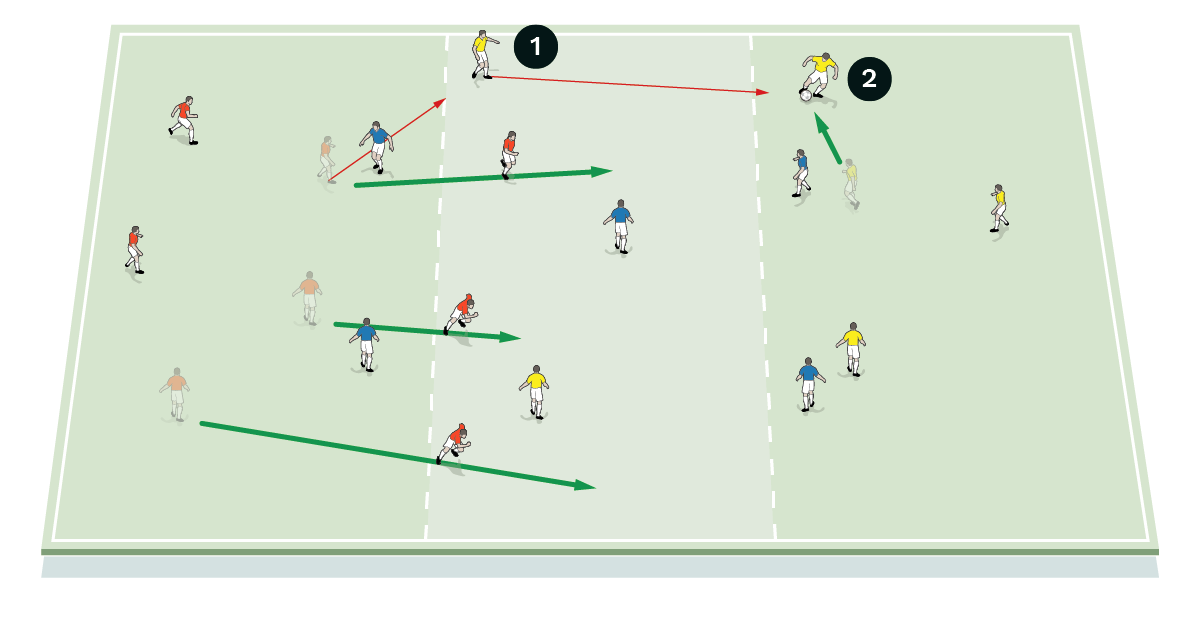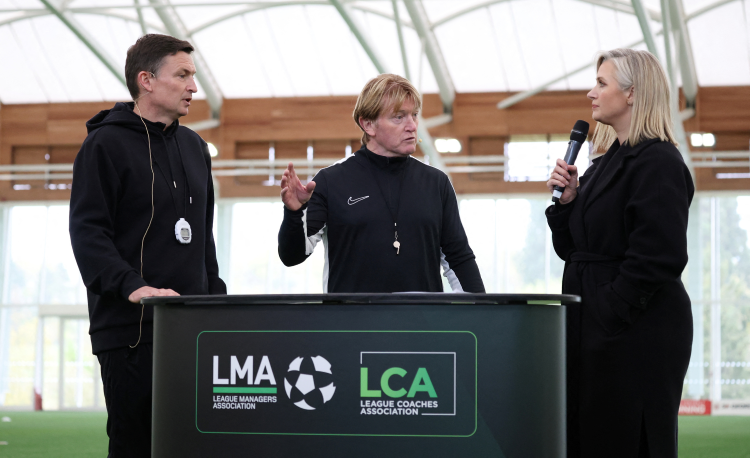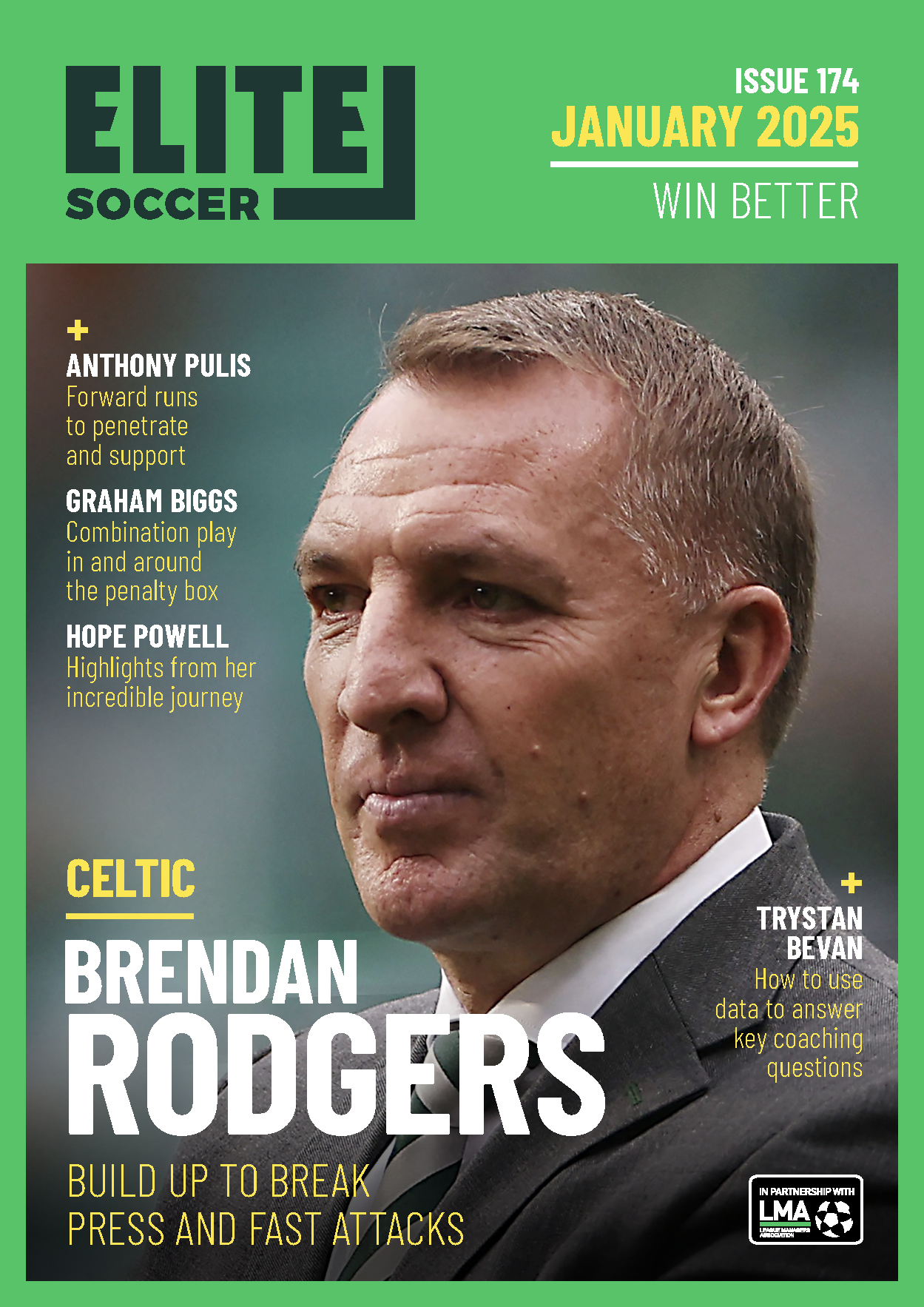You are viewing 1 of your 1 free articles
Principles in possession
In this session we look to identify and coach principles of our team in possession.
| Area | Full pitch |
| Equipment |
None |
| No. of Players | 15 (can be more or less) |
| Session Time | At coach’s discretion |
In this session we look to identify and coach principles of our team in possession. These principles are relevant all over the pitch, particularly when the opposition is organised and in balance, and can be adapted when playing any shape. We will be looking at how we play through pressure by either passing through the pressure, bouncing around the pressure, or driving with the ball through the pressure. Ahead of the ball, we will also require the ability to find space to receive, receive when marked, and support the forward pass.
The more often players perform this session, the more comfortable they become playing quickly. That’s why we enjoy this session.
“These principles are relevant all over the pitch and can be adapted to any shape”
POSSESSION GAME
We begin with a fast-paced possession game, where the players look to work the ball forwards through limited pressure but in tight spaces. There must always be passing options ahead of the ball to allow the team to play away from the pressure, but then quick support is necessary in order to maintain possession and then work the ball back the other way. The confined space requires the players to make quick decisions, combine quickly, and be able to play off one and two touches. This represents the quick play needed to break down teams in the attacking third.
The game takes place in three zones: two end zones, 15yds x 10yds, and a central zone of the same size if we are working with around 15 players. If you have more or fewer, the area can be adapted accordingly.
[1a]

-
15 players are split into three teams of five. A team of five in each end zone, blue team puts two defenders in each end zone and one in the middle zone
- Red team begins with the ball and make five passes
- Yellow team release two players into the middle zone ready to receive the forward pass
With 15 players, split them into three teams of five. A team of five occupies each end zone, with the defending five splitting to supply two defenders in each end zone and a defender in the middle zone.
One of the end zone teams begins with the ball. They look to make five passes (playing 5v2) before they can transfer the ball through the middle zone. While the players are making five passes, the other attacking team of five are releasing two players into the middle zone, ready to receive the forward pass and avoiding the defender in that zone.
The team who began with the ball look to support the pass into the middle zone once they have played it, and combine with the other two attacking players to avoid the defender and safely transfer the ball to the opposite end zone. Any player receiving in the middle zone can turn if unmarked and play the ball directly across.
The opposite team in the end zone now look to make five passes before they transfer through the middle, combining with the players dropping in from the other end zone.
The defending team can be chasing for a set time or challenged to win a certain amount of balls before changing with another team of five.
Depending on time or performance, this session can progress in a number of ways. We would look to challenge the players to play off only one touch in the middle zone, requiring the players to support each other much quicker, and challenging their technique and decision-making relevant to game situations.
[1b]

-
Red team transfers the ball through middle zone and support the pass
- Red and yellow team combine to transfer ball to end zone, avoiding blue defenders
We can also allow the players to transfer the ball after only three passes. Again, this speeds up the game and requires faster support ahead of the ball, with players needing to recognise early opportunities to play forward passes. Another progression we would use is to allow players to drive with the ball into the middle zone, rather than only pass the ball. Again, this is a realistic game decision, and is one of our three principles of playing through pressure.
COACHING POINTS
What are the key things to look out for?
With the ball, we are looking for players to be comfortable in possession and provide team-mates with good-quality service in order to build with the ball. We are also looking for the players to progress the ball forwards through pressure via passing forward through the pressure, bouncing the ball around the pressure, or driving with the ball beyond the pressure.
Ahead of the ball, we want players to be constantly working to receive the ball, and scanning to see where the defenders are as well as their team-mates. We will be looking at their ability to receive in space, with their timing of movement and their body shape to turn if possible, receiving under pressure (protecting the ball and their link play), and supporting the
forward pass.
What are the typical mistakes players might make and how do I avoid them?
Typical mistakes are receiving the ball closed, blocking off, and being unaware of the possibilities of playing forwards. This happens with players in the end zones missing opportunities to play into the middle zone, and also players dropping into the middle zone to receive, unaware that they can turn off one touch.
Another thing to be aware of is the quick support that is necessary when playing forward passes.
Finally, players must be pushed to recognise when they can step in with the ball, away from the pressure (when this progression is introduced).
Related Files
Paul Heckingbottom and Stuart McCall
Editor's Picks
Using the goalkeeper in build-up play
Pressing principles
Intensive boxes drill with goals
Penetrating the final third
Creating and finishing
My philosophy
Pressing initiation
Compact team movement
Defensive organisation
Coaches' Testimonials

Alan Pardew

Arsène Wenger

Brendan Rodgers

Carlos Carvalhal

José Mourinho

Jürgen Klopp

Pep Guardiola

Roy Hodgson

Sir Alex Ferguson

Steven Gerrard
Coaches' Testimonials

Gerald Kearney, Downtown Las Vegas Soccer Club

Paul Butler, Florida, USA

Rick Shields, Springboro, USA

Tony Green, Pierrefonds Titans, Quebec, Canada
Join the world's leading coaches and managers and discover for yourself one of the best kept secrets in coaching. No other training tool on the planet is written or read by the calibre of names you’ll find in Elite Soccer.
In a recent survey 92% of subscribers said Elite Soccer makes them more confident, 89% said it makes them a more effective coach and 91% said it makes them more inspired.
Get Monthly Inspiration
All the latest techniques and approaches
Since 2010 Elite Soccer has given subscribers exclusive insight into the training ground practices of the world’s best coaches. Published in partnership with the League Managers Association we have unparalleled access to the leading lights in the English leagues, as well as a host of international managers.
Elite Soccer exclusively features sessions written by the coaches themselves. There are no observed sessions and no sessions “in the style of”, just first-hand advice delivered direct to you from the coach.








